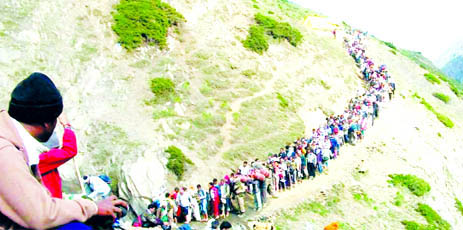Sunil Raina Rajanaka
Everyone who takes part in the annual Amarnath Yatra also pay obeisance to the Sun God at the Martand Tirtha Temple in Anantnag. Even the ‘Charri Mubarak’ or the holy mace of Shiva and Parvati is brought here for prayers before going on to the yatra. Built by King Lalitaditya Muktapida of Kashmir and set amongst chinar trees with a spring flowing close by, the temple is an island of calm and bliss. Muktapida’s desire to connect with one’s true Self might have been really strong to prompt him to build a temple for the Sun God. “The sun shines not only in the physical world but also inside us, removing all traces of darkness, so that we strive for the transcendental Self,” explained my friend, as if reading my thought. During the yatra period, the gardens of Pahalgam are in full bloom. With the river Lidder meandering its way through the town and the snow-capped mountains upright like silent sentinels, the place looks like heaven on earth.
From Pahalgam, I hired a cab to Chandanwari, my first halt en route to the Amarnath cave. Chandanwari is the end point of the road journey. From here, one has to trek 32 km to reach the holy cave of Amarnath, where Shiva revealed the secret of immortality to his consort Parvati; in ancient times, Amarnath was also known as Amreshwar and the details are given in Amreshwar Mahatamaya. I checked into a transit camp at Chandanwari for the night. Shiva released the crescent moon from his dreadlocks here, hence the place got its name, which means a piece of moon. Legend has it that on his way to the Amarnath cave, he released all his adornments on the way.
Looking at the deodar and conifer trees bathed in moonlight, I realised that since moon represents mind and ego – both impediments in our spiritual journey – Shiva left these behind. At daybreak, I set out for my long trek, having completed all registration formalities. The trek to the rocky Pissu Top, the next halt, was treacherous; the path to salvation is rough and the soul requires inner strength to overcome challenges. After an hour, the sun’s rays started falling on the mountains all around. The snowcapped peaks dazzled with the sun’s golden rays and it appeared as if they had donned a golden crown. The scene was a treat for the eyes. At Pissu Top, yatra volunteers had set up community langars, where pilgrims were being served hot tea and paranthas for breakfast. The warmth of the sun along with the gentle breeze, was refreshing and the fatigue of climbing simply vanished. The next milestone was Sheshnag. The trek from Pissu Top to Sheshnag was through an undulating mountain range. Everything was still; it was as if these gigantic mountains were given lessons on peace and tranquility to the pilgrims. Meadows with wild shrubs and numerous streams from the melting glaciers dotted the route. Looking ahead, I caught the first glimpse of the green waters of the Sheshnag Lake, on the banks of which, Shiva released the snake – representing possessions and desires – coiled around his neck. My next stop was Panchtarni, which means five rivulets. Here Shiva released Ganga, who represents continuity, culture, civilisation and knowledge. The five rivulets also represent the five elements – earth, water, air, fire and sky. From Panchtarni to the entrance of the Amarnath cave, the trek gets tougher as one has to negotiate rocky terrain, icy streams and frozen passes. But the experience that awaits one at the end of the climb makes up for the grind. After taking the customary bath, I climbed the stairs to the cave.
The moment my eyes fell upon the Shiva Lingam, I stood rooted to the spot. An electric current ran through my body and I was in a state of bliss. Inside the cave, every year, a white ice lingam takes shape. Water trickles mysteriously from the roof of the cave and freezes into ice. It first forms a solid base and then a lingam begins to rise and acquire full form on Purnima or full moon day. After due oblations, I left the cave and walked to the spot to collect my belongings, but my boots were missing. I got annoyed at the poor arrangements for the pilgrims. Had I come all the way up to lose my boots? May be someone needed them more than me. Or was Shiva testing my endurance? With these conflicting thoughts, I climbed down the steps and started walking. A short distance away, I saw a man in rags wearing similar boots. I went up to him, smiled and pointed towards the shoes and asked if they belonged to him. He said no and started removing them. I told him to keep the boots. I had another pair anyway.
I was surprised at my own magnanimity. Perhaps there was a shift in consciousness as I didn’t attach much value to smaller things. On my way back, I crossed the Sangam river, then Brarimarg and finally reached Baltal, a scenic meadow nestling on the banks of the Indus river. Coming downhill, I realised that spiritual journeys are full of trials and tribulations, which an ardent devotee finally overcomes. Perhaps, this triumph is, called Self realisation.


